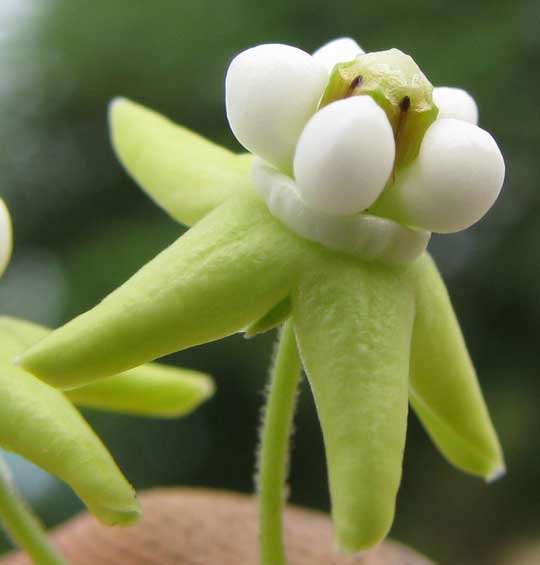Excerpts from Jim Conrad's
Naturalist Newsletter

from the November 21, 2010 Newsletter issued from Hacienda Chichen Resort beside Chichén Itzá Ruins, central Yucatán, MÉXICO; limestone bedrock, elevation ~39m (~128ft), ~N20.676°, ~W88.569°
A SHY LITTLE VINE
Occasionally over the years I've mentioned having once worked as a botanical illustrator at the University of Bayreuth, Bavaria, Germany. For scientific publications I drew the tiny flowers of a certain kind of "climbing milkweed." Now whenever I run into plants of that group it evokes good memories of a past life and I wonder which species I have. I ship pictures of my finds to my friend Ulli still back at the Uni, who continues doing research on the group, and he tells me what I've found.
So, last week a species not yet featured here appeared climbing over a stone wall in Pisté. That's it above. A flower, looking very much like the blossom of a common milkweed, is shown below:

Ulli says that this is FUNASTRUM BILOBUM. Those dark items between the white, oval things (corona lobes) are "pollinarium glands," each bearing two leglike "pollinia" descending behind the corona lobes, so that gland and pollinia form an upside-down V. When an insect's leg slips between the corona lobes, it catches in the narrow angle formed where the V's arms join, and the whole V structure is torn from the flower and carried to another flower on the insect's leg. That's what the flower wants, since the pollinia consist of waxy, packed-together globs of pollen. When pollinia are left on the next flower's "cap," pollination will be accomplished.
Back in Yokdzonot we met another Funastrum species, Funastrum lindenianum. You might enjoy comparing our current species with that other one at www.backyardnature.net/yucatan/funastru.jpg.